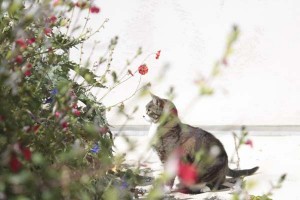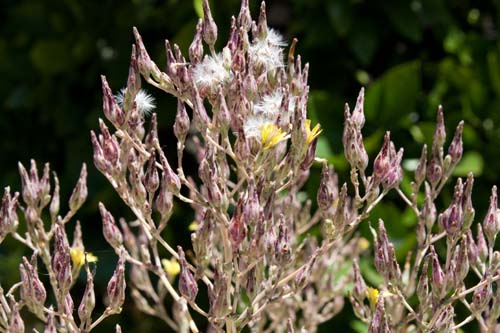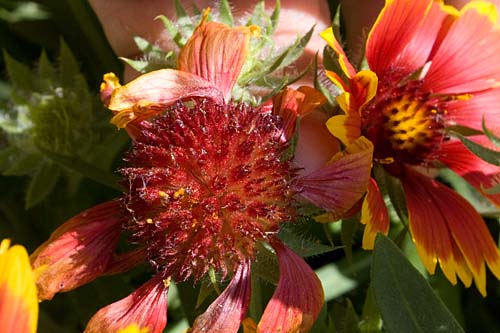Sunny and warm: a perfect morning for cats and gardeners. The cat had her chores, mainly to stare at interesting things in the garden, and I had mine.
Task #1 was to deadhead the arctotis (African daisy) that has been blooming for several months. This is the “before” on one plant…
…and the “after” on another. Arctotis goes on blooming regardless of whether it’s been deadheaded or not. But the plants looked like they were winding down for the year, and I was hoping to extend their season a bit.
The plants are attractive, but I thought the bucket of trimmings was pretty cool, too.
Chore #2 was to weed one of the patches of bromeliads that we’d let loose in the back of a raised bed.  The plant has rigid spines like teeth on a sharp saw blade, which makes weeding tricky, and forces you to ask yourself, “Do I really want to do this?”
The plant has rigid spines like teeth on a sharp saw blade, which makes weeding tricky, and forces you to ask yourself, “Do I really want to do this?”
John started on the task and ended up with bloody forearms. Not happy. He went for the pitchfork, thinking we could lift the clumps, weed under them, and then set the clumps back. These are plants with almost no roots, and that would have worked fine.
But I proposed another idea. I have these long cordura motorcycle gauntlets that I use when I ride my scooter when it’s cold out. They protect your hands, but also your forearms. Would those work for the garden, too?
I suited up, first a thick long-sleeved sweatshirt, and then the gauntlets. Okay, it’s not particularly haute couture, and it’s not a look I’d want to inflict on the world. But it worked.
 Why all this effort? Well, the flowers are pretty stunning right now in an unrestrained, tropical way. And the plants are surprisingly drought-tolerant.
Why all this effort? Well, the flowers are pretty stunning right now in an unrestrained, tropical way. And the plants are surprisingly drought-tolerant.
Weeding around them seems to be the main challenge. But now we’ve got an easy solution…
(Addition, May 9, 2012: Thanks to Kathryn who commented with a probably ID. Tracking down her lead led be to the Florida Council of Bromeliad Societies’ Bromeliad Species Database, where the best fit seems to be Aechmea distichantha v. glaziovii. You have no idea how much it bothers me to have a plant that I don’t know the name of, so it’s one more down, a few dozen in the garden to go…)









 Of these two flowers, the one on the left is ready to be removed.
Of these two flowers, the one on the left is ready to be removed. A week’s worth of spent flowers, ready for the recycling or compost.
A week’s worth of spent flowers, ready for the recycling or compost.